Twin Towers of Dubai: Architectural Marvels and Impact
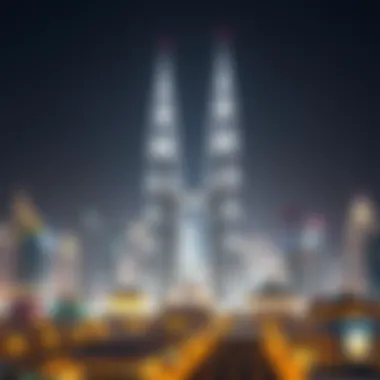
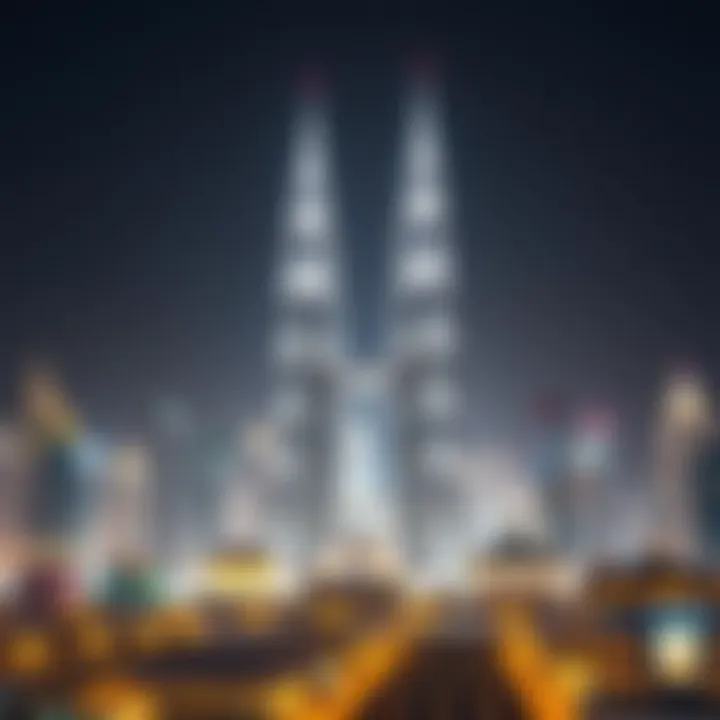
Intro
The skyline of Dubai is simply a testament to modern architectural genius. Among its most striking features are the Twin Towers. These structures are not only tall and impressive; they represent an evolution in design and urban lifestyle within the emirate. Built with a vision to symbolize progress, the Twin Towers are integral to Dubai's identity and have become landmarks recognized worldwide.
From their sleek exteriors to their culturally rich interiors, the Towers embody both style and substance. The dual structures captivate the imagination, serving as a practical space for businesses as well as a canvas for artistic expression.
Designed with the harsh desert climate in mind, the engineering behind these buildings incorporates innovative materials and methods. This attention to detail reflects the ambition of Dubai – a city that seeks to push boundaries and challenge norms in architecture and urban development.
As we delve into the various aspects of the Twin Towers, we uncover not just their aesthetic allure, but the profound economic and cultural impacts they have had on Dubai. Their existence has led to a boom in real estate, attracting investors from across the globe. This exploration reveals how the Twin Towers serve as both a beacon of opportunity and a symbol of the city’s aspirations for the future.
Prelims to the Twin Towers
The Twin Towers stand as a striking visage against the ethereal skyline of Dubai, where the blend of art and engineering creates a unique narrative. This article delves into the significance of these architectural masterpieces, illuminating their impact not just on the city’s landscape but also on the cultural and economic fabric of the region. Readers will find that understanding these structures is akin to gazing through a keyhole into Dubai’s ambitious spirit. Here, the Twin Towers are not merely buildings; they symbolize the relentless drive for innovation and luxury that defines this vibrant city.
Historical Background
The roots of the Twin Towers extend back to the early 2000s, a period characterized by rapid urbanization and economic growth in the United Arab Emirates. Erected in a city striving to push the boundaries of modernity, the towers reflect a blend of traditional Islamic architecture and contemporary design practices. Their construction commenced in 2006 and was completed in 2010, marking a significant period of development in Dubai. The towers were designed by the renowned architectural firm of Kohn Pedersen Fox and stand at an impressive height of 335 meters, making them one of the tallest buildings in the region.
During this time, Dubai was eyeing the global stage, wanting to showcase not only its wealth but also its cultural advancements. The towers were envisioned to represent a new era in Dubai’s architectural landscape—a clear statement that the emirate is not just a city of the desert. With this significance, the Twin Towers were positioned strategically in the heart of the business district, acting as a beacon for international travelers and investors alike.
Purpose and Significance
The Twin Towers serve multiple purposes, both functional and symbolic. Primarily, they house a variety of office spaces, luxury apartments, and upscale retail outlets, cementing their role as a hub for commerce and lifestyle choices. Their location is designed to attract not just businesses but also tourists looking for a taste of the lavish lifestyle associated with Dubai.
In a more profound sense, these towers embody the aspirations of Dubai for a future where architectural innovation is harmoniously linked with cultural identity. They signify the city’s ambition to cultivate a global presence, blend old with new, and continually redefine itself.
"The Twin Towers are more than just structures. They are a mirror reflecting Dubai’s ambitious heart and soul, constantly evolving and thriving."
This multifaceted significance extends beyond mere business; it intertwines with the cultural narrative of Dubai, encouraging a cosmopolitan lifestyle that embraces diversity and modernity. For investors and homeowners, the Twin Towers symbolize not only a luxurious living experience but also a prime investment opportunity within a city renowned for its dynamic real estate market.
Through these lenses, the Twin Towers of Dubai continue to be an enduring emblem of architectural prowess and cultural depth in the ever-evolving landscape of this metropolis.
Architectural Overview
When dissecting the architecture of the Twin Towers in Dubai, it’s essential to recognize that these structures do not merely serve as buildings. Instead, they manifest the ambitions, aspirations, and cultural dialogues of a city that has rapidly transformed itself through the tides of time and economic growth. The architectural overview sets the stage for understanding not just the aesthetic appeal but also the functional aspects that make these towers a marvel in the skyline.
Design Features
At first glance, the design of the Twin Towers is undeniably captivating; they rise majestically against the backdrop of a stunning horizon. The aesthetic is heavily influenced by Islamic architecture, a nod to Dubai's rich cultural heritage. This is apparent in their pointed arches and the intricate facades, which also serve a practical purpose.
Key aspects of the design include:
- Vertical Emphasis: The towers are built to draw the eye upward, symbolizing the aspirations of Dubai itself. This verticality not only enhances the skyline but also maximizes space in a city where land is a premium.
- Dynamic Facade: The use of reflective glass creates an ever-changing appearance as the light interacts with the buildings throughout the day. This design choice imbues life into the structures, allowing them to resonate with their environment rather than dominating it.
- Sustainable Elements: The buildings incorporate elements such as energy-efficient climate control systems and rainwater harvesting. These features reflect a growing awareness of environmental stewardship amidst urban development.
Each of these design features speaks to a broader conversation—challenging norms in architecture while embedding cultural significance, blending modernity with tradition.
Materials Used
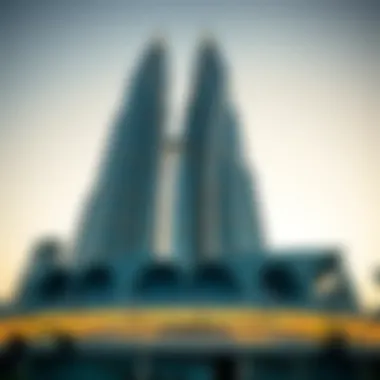
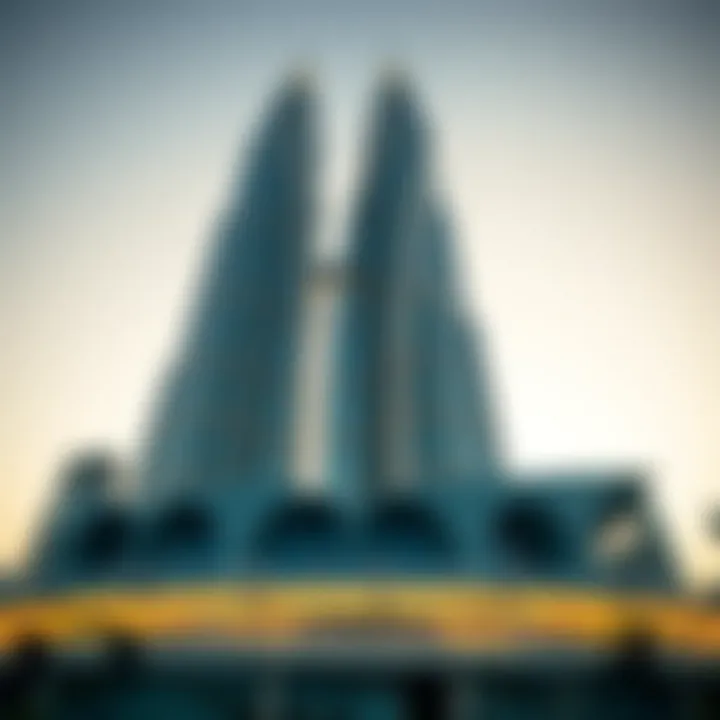
The materials selected for constructing the Twin Towers are pivotal in defining both the form and function of the buildings. Quality and durability were the main priorities, as each choice contributes to the overall longevity and resilience of the structures against weather and time.
Some key materials include:
- Reinforced Concrete: Chosen for its strength and durability, reinforced concrete provides the necessary support for such tall structures. It assures stability and safety, which is crucial in high-rise building design.
- Glass: The extensive use of glass not only adds to the aesthetic appeal but also enhances natural light penetration inside offices and public spaces, fostering a pleasant working and living environment.
- Steel: Steel beams contribute to the structural integrity needed for such tall towers. They provide flexibility in the face of wind loads, allowing the buildings to sway slightly without compromising safety.
These materials work in synergy to create a robust foundation that can withstand both the elements and the passage of time, securing the Twin Towers a place as perennial symbols of Dubai’s architectural landscape.
"A structure isn’t merely a building; it's a story etched into the skyline, showcasing the dreams and desires of a community."
Construction Insights
Understanding the construction insights behind the Twin Towers of Dubai is key to appreciating their stature and significance in the Middle East's architectural landscape. These insights not only reveal technical prowess but also showcase the ambition and vision that propelled Dubai into the limelight. The construction phase of such a monumental project entails meticulous planning, innovative techniques, and a dedicated workforce, all of which contribute to the structures’ underlying resilience and functionality. The Twin Towers serve as benchmarks for future developments, particularly in terms of sustainability and modernization.
Timeline of Construction
The journey of erecting these twin architectural giants began in the early 2000s. The groundbreaking ceremony took place in 2002, marking the initiation of extensive groundwork that was not merely about laying foundations but redefining the boundaries of engineering. Each phase of construction came with its own set of challenges and milestones:
- 2002: Groundbreaking ceremony; preparation of the site.
- 2004: By mid-2004, the structure began to rise as the foundations and lower levels were completed.
- 2006: The towers reached significant heights, catching the eyes of Dubai residents and future investors alike.
- 2008: Structural completion, with the installation of the primary facade and necessary amenities.
- 2011: The Twin Towers were officially inaugurated, marking their entry into Dubai’s skyline.
This timeline not only encapsulates technical ambition but also captures the rapid-paced growth of a city that thrives on progress. Every step reflected a strategic approach to blend modern architecture with cultural heritage, a hallmark of Dubai's vision in transforming its urban landscape.
Techniques Employed
The construction methods used in the Twin Towers project are a study in innovation and efficiency, reflecting both traditional practices and cutting-edge technology. Some of the key techniques include:
- Top-Down Construction: This method allowed work on the superstructure and substructure to proceed simultaneously, saving precious time. Instead of typical bottom-up construction, developers began work on upper floors while still digging out the foundations below.
- Advanced Materials: Utilization of high-strength concrete and specialized steel reinforced the structural integrity of the towers. The choice of materials ensured longevity and resistance to the harsh desert climate.
- Modular Construction Techniques: Prefabricated elements were used where possible, which streamlined the building process, reduced waste, and ensured quality control from the factory to the site.
- Cranes and Lifting Equipment: Massive cranes capable of lifting heavy concrete and steel components efficiently were integrated into the site. This allowed for larger sections to be constructed off-site and quickly assembled on location.
The approach to construction mirrored the ambition and essence of Dubai itself: fast-paced, innovative, and unwavering in the pursuit of excellence.
As a result of these techniques, the Twin Towers not only rose within a remarkably swift timeline but did so with an emphasis on durability and sophistication, proving to be more than just buildings but rather symbols of a dynamic city's progress and future aspirations.
Economic Impact
The Twin Towers of Dubai are not just architectural feats; they serve as crucial economic catalysts for the region. Their towering presence is a testament to the city’s ambitious vision and highlights the interplay between innovative design and economic growth. In this section, we will delve into two key areas of economic impact—how these structures bolster the local economy and their influence in shaping the real estate market.
Contribution to Local Economy
The contribution of the Twin Towers to the local economy cannot be understated. These structures house a variety of businesses, from global corporations to start-ups, creating thousands of jobs and attracting a diverse workforce. As bustling hubs of activity, they offer facilities that encompass offices, retail spaces, and entertainment venues, catering to both residents and visitors alike.
- Job Creation: The construction and ongoing operations of the Twin Towers have directly and indirectly generated numerous employment opportunities. During construction, thousands of skilled workers and contractors played critical roles, while post-construction, a myriad of jobs emerged in management, security, and maintenance.
- Increased Tourism: The architectural magnificence of the Twin Towers draws in tourists from around the world. Visitors hustle in for business conferences, exhibitions, or just to marvel at the design. The influx of tourists often leads to increased spending in local businesses, from hotels to restaurants.
- Enhanced Infrastructure: The development and success of the Twin Towers have led to improved infrastructure in the surrounding areas. Roads, public transport, and utilities have been upgraded to accommodate not just the buildings, but the growth of the entire locality.
"The Twin Towers serve as a magnet for both businesses and tourists, driving economic activity in ways that ripple throughout the community."
Real Estate Market Influence
The presence of the Twin Towers has had a profound influence on the real estate market in Dubai. Given their iconic stature, they encourage development and investment in surrounding areas, transforming the entire skyline.
- Rising Property Values: Properties near the Twin Towers have often seen a significant uptick in value. Investors recognize the prestige associated with living or working near such prominent structures, leading to competitive pricing in the real estate market.
- Mixed-Use Developments: The success of the Twin Towers has spurred developers to pursue mixed-use projects in the vicinity. This includes the incorporation of residential, commercial, and leisure spaces that appeal to a broader demographic, fostering a sense of community.
- Market Trends: As a benchmark, the Twin Towers have set the standard for luxury and modern living. Their impact on market trends can be seen in the rising demand for high-end amenities and sustainable living practices among new developments.
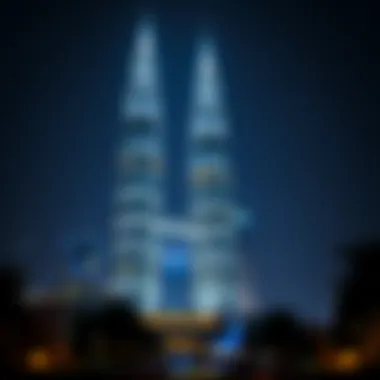
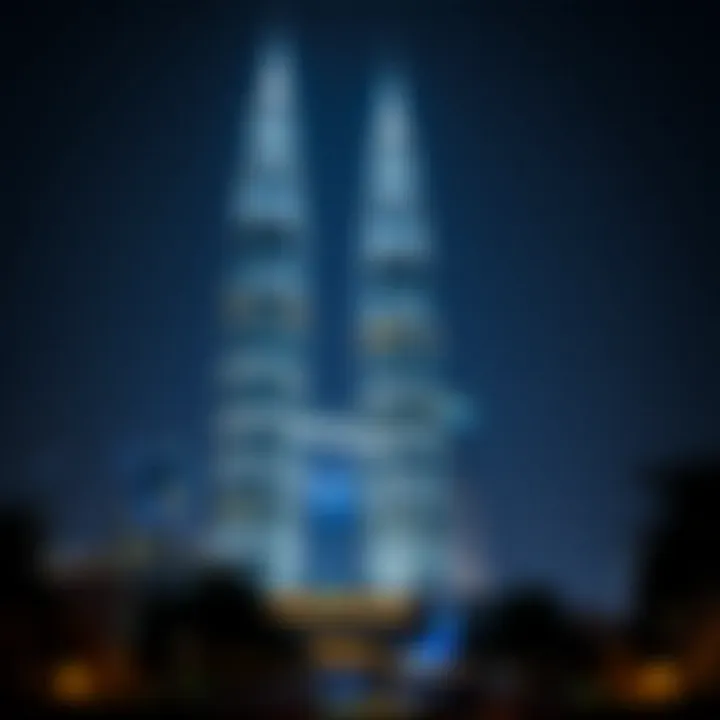
Cultural Significance
The cultural significance of the Twin Towers in Dubai goes beyond their towering presence in the skyline; they symbolize the spirit and ambition of a city that has transformed fundamentally over a few decades. As skyscrapers, they represent a blend of modernism and traditional values, encapsulating the journey of Dubai from a small trading post to a bustling metropolis. These towers are not merely architectural feats; they serve as iconic landmarks that reflect the cultural ethos of the region.
Representation of Dubai
When one gazes at the Twin Towers, it becomes apparent that they embody the identity of Dubai. They represent not just the economic boom but also the local heritage and aspirations of its people. The design subtly incorporates traditional motifs, suggesting that while Dubai is forward-thinking, it doesn't entirely forget its roots. These towers stand like sentinels, welcoming visitors and inhabitants alike, while preserving the cultural narratives of the past.
The towers are often featured in local media and literature, reinforcing their status as cultural symbols. They provide a backdrop for various cultural events and activities, thereby promoting a sense of community among residents. Their silhouette at sunset is a cherished view, representing not just a geographical landmark but a symbol of hope and opportunity.
Role in Tourism
The Twin Towers play a pivotal role in attracting tourists to Dubai, drawing visitors far and wide, fascinated by their grandeur. Tourists are encouraged to visit the observation decks where they can marvel not only at breathtaking views but also at the architectural brilliance of these skyscrapers.
Here’s how the Twin Towers enhance the tourism landscape:
- Photography Hotspot: Tourists often flock to these towers for that perfect Instagram shot, making them part of the Dubai experience.
- Cultural Exposure: Events hosted in and around the towers often feature local arts and crafts, providing visitors insight into Emirati culture.
- Economic Ripple Effect: Increased tourism around the Twin Towers boosts local businesses, from cafes to retail shops, contributing to a vibrant economic cycle.
"The Twin Towers are not just structures; they are gateways into the heart of Dubai's cultural tapestry."
As a magnet for tourists, the Twin Towers help reinforce Dubai's reputation as a premier destination for luxury and leisure.
Enhancing the visitor experience is key; many travel guides emphasize the significance of the Twin Towers, enhancing their allure and ensuring that they remain a must-see for tourists. Their contribution to the cultural and economic fabric of Dubai underscores the dual narrative of modernity and tradition that characterizes this dynamic city.
Lifestyle and Community Impact
The Twin Towers of Dubai do not just stand tall as architectural giants; they embody a lifestyle and community essence that resonates deeply with residents and visitors alike. These structures have become more than mere buildings; they have transformed into vibrant hubs that cater to countless aspects of living and working in a modern metropolis. As we examine this topic, it reveals the importance of the Twin Towers in shaping an engaged community through their amenities and facilities, along with the overall living and working environment they provide.
Amenities and Facilities
Amenities surrounding the Twin Towers enhance the quality of life for those who live and work in the area. They include:
- Retail Spaces: The ground levels of the towers are equipped with numerous retail outlets ranging from high-end fashion boutiques to casual cafes, catering to both local needs and tourists’ desires. People can easily access what they need without venturing too far.
- Recreational Areas: Parks and rooftop gardens provide green spaces that promote relaxation and outdoor activities, essential in a bustling city where green spaces are often limited. Residents can unwind in lush settings, enjoying a break from the urban hustle.
- Health and Wellness: Gyms, spas, and wellness centers are vital for health-conscious individuals. The Twin Towers accommodate various fitness options, promoting a balanced lifestyle amidst a fast-paced environment.
- Public Transport Connectivity: The area’s transport infrastructure is designed for convenience. With metro stations and bus services nearby, commuting becomes a seamless experience for both residents and workers.
These facilities enhance community living, providing residents with everything needed for a comfortable and fulfilling life. Such access creates a sense of community, drawing people together within this iconic space.
Living and Working Environment
The living and working environment around the Twin Towers reflects a harmonious blend of modernity and tradition. Here are some significant points:
- Diverse Living Options: The area presents an array of housing options, from luxurious apartments to more affordable accommodations, catering to different demographics and budgets. This diversity attracts a mix of cultures and backgrounds, enriching the community experience.
- Innovative Workspaces: Businesses thrive in the vicinity, with many tech firms and corporate offices occupying prime locations. Flexible office spaces with modern amenities foster collaboration and innovation, making it an attractive spot for entrepreneurs and established businesses alike.
- Community Engagement: Regular events, markets, and activities organized in and around the Twin Towers encourage interaction among residents. These gatherings foster a sense of belonging, turning the area into a connected community instead of just a place to live and work.
- Safety and Security: The towers and their surroundings prioritize safety with surveillance, security personnel, and well-maintained public spaces. This enhances the peace of mind for those who live and work there, making it a prime location in Dubai.
In many ways, the Twin Towers of Dubai reflect the aspirations of a modern lifestyle while maintaining elements of community spirit. Their impact extends beyond architecture; they shape a lifestyle that resonates with diverse groups of people, solidifying their role as essential pillars in the urban landscape of Dubai.
The Twin Towers serve not just as architectural landmarks but as facilitators of life, community, and connection in the bustling heart of Dubai.
For more insights on architectural significance and urban living in Dubai, visit Wikipedia's page or check relevant discussions on Reddit.
Environmental Considerations
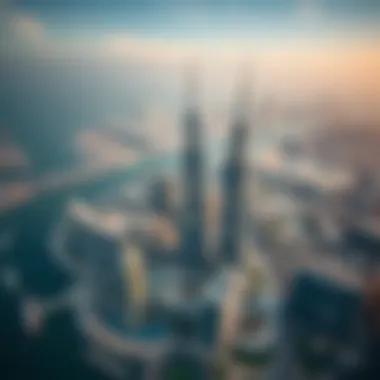
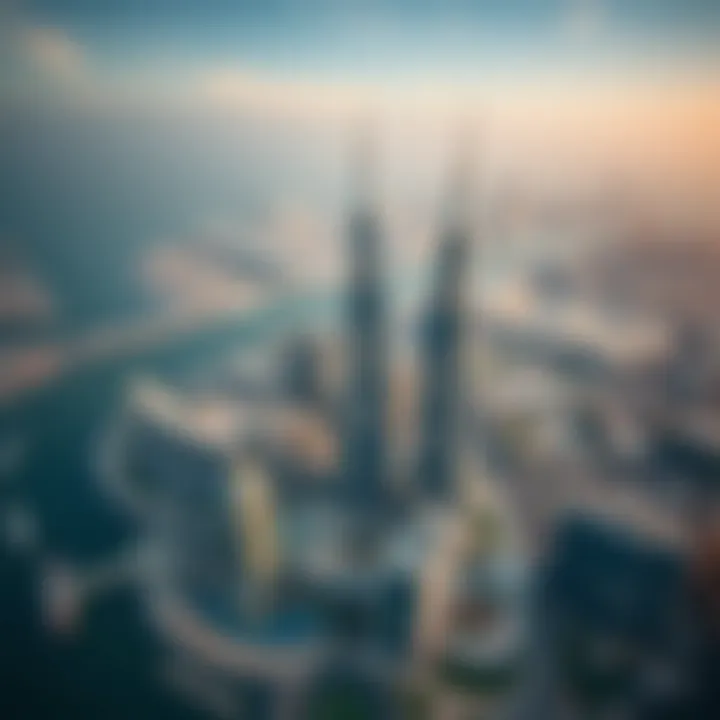
The significance of environmental considerations when discussing the Twin Towers of Dubai cannot be overstated. As urbanization burgeons, particularly in the Middle East, the need for sustainable practices becomes crucial. These towers, besides their undeniable architectural grandeur, must also reflect a commitment to environmental stewardship. In the case of the Twin Towers, their development did not merely prioritize aesthetics; it aimed to weave eco-friendly principles into the very fabric of their existence.
Sustainability Initiatives
Sustainability initiatives around the Twin Towers manifest in several crucial ways. Firstly, the choice of materials plays a pivotal role. Environmentally friendly construction materials are utilized, aimed at minimizing the carbon footprint. The towers also incorporate green roofs and living walls, which not only enhance aesthetic appeal but also contribute to reducing the urban heat island effect.
In addition to these materials, there is a strong emphasis on water conservation. Advanced irrigation systems are utilized, promoting the efficient use of this precious resource amidst a desert environment. Rainwater harvesting systems are also in place, allowing the buildings to utilize nature’s resources efficiently, contributing to a more sustainable operational model.
Moreover, the Twin Towers have embraced smart technology initiatives for waste management and monitoring resource usage. These smart systems gather data on energy consumption patterns, facilitating efforts for continuous improvement in sustainability, ensuring peak operational efficiency.
Energy Efficiency Models
Energy efficiency forms the backbone of the operational strategy for the Twin Towers. By harnessing innovative technologies, the towers exemplify how energy consumption can be minimized while maintaining high standards of comfort and utility. One notable strategy is the deployment of energy-efficient HVAC systems, which regulate temperatures effectively without excessive energy use.
Solar panels also adorn significant parts of the building facade. This harnesses renewable energy, further reducing reliance on conventional power sources, complementing the overall energy model of the towers. By integrating solar energy, the Twin Towers align with Dubai’s broader commitment to sustainability practices outlined in various governmental initiatives, such as the Dubai Clean Energy Strategy 2050.
"Sustainable architecture isn't just a trend; it's a necessity for future urban developments, especially in areas prone to rapid growth."
Among other energy-saving features are the use of high-performance glazing techniques, which enhance insulation while ensuring ample natural lighting. These models not only keep utility costs at bay but also play a role in reducing the overall environmental impact of the buildings.
Future Prospects
The future prospects for the Twin Towers of Dubai indicate a trajectory filled with potential and progress. As the city continues to evolve, the towers are not only symbolic architectural achievements but also pivotal players in the expansion plans for Dubai. Their impact transcends mere aesthetics, shaping economic opportunities and influencing urban development patterns.
Planned Developments in the Area
In the vicinity of the Twin Towers, ambitious developments are on the horizon. Projects aimed at enhancing urban connectivity and accessibility are being introduced, reflecting a commitment to modern urban planning. Initiatives, such as the expansion of the transport network, promise to ease transit, linking residents and visitors to the broader city. Moreover, the redevelopment of surrounding areas into mixed-use hubs is underway.
These new neighborhoods will house amenities including retail shops, parks, and cultural venues, fostering a vibrant community atmosphere. Such developments not only stand to invigorate foot traffic in the area but also promote local economy by providing jobs and attracting investors.
Long-Term Vision for Dubai
Dubai has always harbored grand aspirations, and the future vision for the city remains aligned with its reputation for innovation. The government envisions leveraging the twin towers as catalysts for economic diversification beyond the oil industry. By investing in technology, tourism, and sustainability, the goal is to position Dubai as a global knowledge and business hub well into the future.
Furthermore, initiatives focused on sustainability are integrating green technologies into construction practices and urban designs. This is evident in plans to enhance energy efficiency and promote environmentally conscious living. The long-term strategy aims for Dubai to not just be a city of the now, but an enduring model for future urbanism.
"Dubai’s future is built on the foundations of its past; the Twin Towers stand as a reminder that our skyline reflects our aspirations."
Through these developments and initiatives, the Twin Towers will become integral in defining the landscape of a city poised for sustained growth and continued allure in the global arena. The architectural marvels are expected not only to stand tall but also enlighten what lies ahead for a dynamically evolving Dubai.
Closure and Final Thoughts
The Twin Towers of Dubai stand not only as impressive architectural feats but also as cultural touchstones that encapsulate the spirit and ambitions of a growing metropolis. Their significance extends beyond mere aesthetics; they serve as vital components in understanding the economic, cultural, and environmental fabric of Dubai. In this conclusion, we will dive into the key takeaways from our exploration of these iconic structures and reflect on their ongoing legacy.
Recap of Major Points
- Architectural Brilliance: The design and structural innovation behind the Twin Towers have garnered international attention, showcasing Dubai's commitment to cutting-edge architecture.
- Economic Contributions: These towers have fueled local economic growth, drawing in investments and enhancing the real estate market in the surrounding areas.
- Cultural Relevance: The towers symbolize Dubai's rapid development and are a representation of the city’s identity, merging tradition with modernity.
- Community Impact: With a variety of amenities and services provided, the Twin Towers foster a vibrant community atmosphere, enhancing lifestyle options for residents and visitors alike.
The Legacy of the Twin Towers
As we gaze upon the skyline of Dubai, the Twin Towers will always be more than just buildings—they represent a vision and a bold statement about what the future holds. Their legacy is multifaceted:
- Inspiration for Future Developments: The architectural advancements and sustainability initiatives seen in these towers set a benchmark for future projects in the region. Developers and architects look to these structures as they design their own, carving out the next generation of skyline.
- Cultural Milestone: The towers have cemented their place in Dubai’s cultural narrative. They are regularly featured in promotional materials and tourism campaigns, serving as a source of pride for local residents and a must-see for visitors.
- Economic Beacon: As landmarks, they continue to attract global investment, reinforcing Dubai's position as a key player in the international market.
In summary, the Twin Towers of Dubai encapsulate the ambitions of a city that refuses to stand still. They are markers of progress, innovation, and resilience. As developments continue to rise around them, their legacy will likely inspire not just admiration, but also a sense of community ownership and pride. For investors, homeowners, real estate agents, and tenants, understanding the significance of such landmarks is crucial as they navigate the evolving landscape of Dubai's real estate sector.















